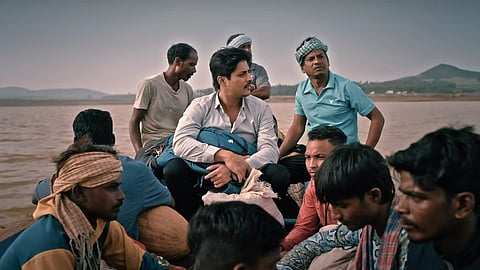
- Reviews
- Power List 2024
- Cannes 2024
- In-Depth Stories
- Web Stories
- News
- FC Lists
- Interviews
- Features
- FC SpecialsFC Specials

Rishabh Shetty recently said, “The more rooted you get, the more universal is the appeal”. Directed by Vijay Maurya and Debi Prasad Lenka, the Odia film DAMaN is a manifestation of this belief. Made on a shoestring budget, Daman is based on the true story of a brave young Dr.Raut who helped change the lives of the tribals in the cut-off areas of Malkangiri District of Odisha. DAMaN is an acronym for Durgama Anchalre Malaria Nirakarana, a program conceptualized by the protagonist of the film Siddharth (Babushaan) and implemented through collaboration of various government agencies. The aim of the program was to eradicate Malaria from the 151 inaccessible areas in the Malkangiri. The story of how the district went from being the most malaria affected area in the country to near complete eradication is a marvel of human achievement.
Sidharth, a young doctor, is unwillingly sent to a remote village in Malkangiri to work in the public health care center. Unwillingly, because as per the government bond, doctors must work for three years in the rural sector before they are eligible to go for their postgraduate degree and subsequent greener pastures. The city-bred Sidhharth is in for a shock of a lifetime. It might remind one of Mohan Bhargav’s situation in Swades but the devil lies in the details. Mohan Bhargav was blissfully unaware of the ground realities sitting thousands of miles away in the developed world. Sidharth has lived a cocooned existence, barely 200 KMs from these remote areas of his state. He enters the district the same way I have seen my friends from cities make their way into rural areas, wide-eyed and amazed by the Instagram-friendly hills, lakes and natural beauty. The diseases and death in these tribal regions is blamed on superstitions, systemic apathy, and lack of awareness. The solution to these problems is brought in not through any divine intervention but in science and logic.
Sidharth’s amusement starts dissolving the moment he alights from his bus as he faces challenges of commute, lack of electricity and absence of network. Is there a point in even living in a picturesque place, if there is no virtual world to show it to. Like any other person in his place, he decides to immediately leave. That is, until he sees the difference a doctor can bring in the lives of the people from the region. What starts of as an effort to cure people who can reach the healthcare center soon blooms into a full-blown mission to suppress the biggest antagonist in the story: mosquitoes. This might sound outrageous to an outsider but for people who hail from these regions, it is the reality of existence. Left unchecked, mosquitoes can cause tremendous havoc, especially towards people who are cut-off from basic healthcare amenities.
DAMaN is a breathe of fresh air a midst the monotony of mainstream Odia cinema. This small industry is at a stage where the Kannada industry was pre-Lucia – stuck in the rigmarole of remakes. For a star from that space to play the lead in DAMaN is a hopeful change. For Vijay and Debi to conceptualize this film is another milestone. The treatment of the story is delightfully mainstream. The entry of the villagers is not preceded by forced melancholic music. Life is depicted as-is – there is the grim poverty but there is also the simple joy of living. Characters speak the dialect and the language of their origins – Sidharth who comes from Bhubaneshwar speaks Odia differently from his assistant Rabi (played by a dependable Dipanwit who has starred in some remarkable offbeat films like Khyanikaa and Adieu Godard). Same goes for the tribals who have their distinct language and the naxal leader who hails from the neighbouring Andhra Pradesh. So rooted is DAMaN in its world that the story it tries to convey, that it becomes authentic and universally appealing.